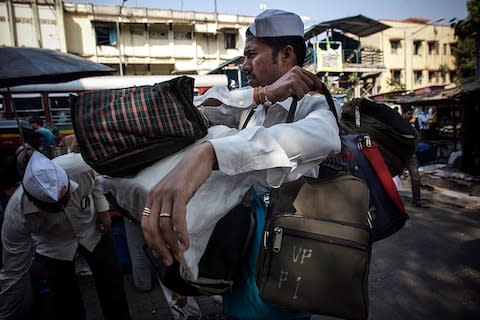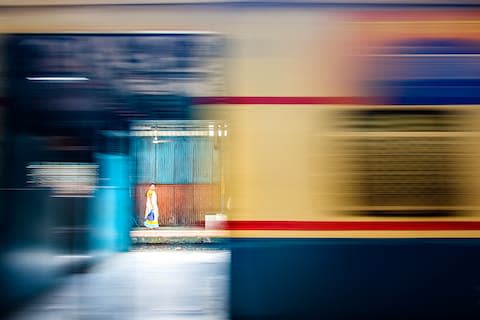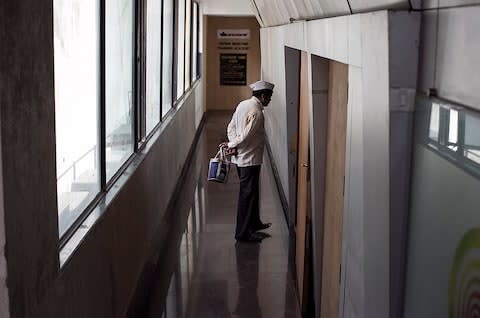The world's greatest delivery service? How Mumbai's dabbawalas send home-cooked meals to 200,000 a day

Like millions who come into Mumbai to work each day, Santosh Apte’s life is pretty humdrum. In fact, a bit of actual humming or drumming might enliven it. Apte works in India’s commercial megalopolis for a company exporting saris.
He sits at a computer in a small grey, windowless office lit by sallow neon. His first-floor room – little more than a cupboard – is a short walk from the city’s Churchgate railway station.
Yet every day his wife cooks him lunch: lentils with love, straight from her kitchen and her heart. He doesn’t go home to eat; that would take two hours by train. Nor does his wife join him. No, Mr Apte’s lunch, along with 200,000 others, reaches him by arguably the world’s most remarkable delivery service.
Mumbai’s dabbawalas are as close as mankind has come to creating pixie dust. They distribute 200,000 home-cooked lunches a day, six days a week in India’s most densely populated city. On an imaginative excursion from a Fred Olsen cruise, I joined a group of dabbawalas on their frenetic morning missions.
For a little context, our first stop was to follow a dabbawala up to Mr Apte’s pokey office. Dabba is a lunchbox, wala, the man who carries it; the service was founded in 1890. There are 5,000 walas, taking meals to office workers in the morning and returning the empty containers in the afternoon. The operation, unique to Mumbai, is run as a co-operative and costs its customers between £5 and £15 a month. The walas, who all come from the Hindu Vakari sect, are paid as much as £200 a month.

With around 120 tons of lunch transported daily, it makes Deliveroo look like an idle game of pass-the-parcel. Without a single computer in the system, their error rate is reckoned to be one in eight million.
The operation was like an exquisite form of anarchy, like 1,000 relay races, the batons being the lunchboxes, run simultaneously in medleys of foot, bicycles and trains. Our guide knew exactly where to stand on platform three of Mahalaxmi station to find a particular luggage compartment. With the stop scheduled for 17 seconds, there was no time to waste. Station life swirled around us: porters threaded wooden carts through hordes of commuters; women in vivid saris sat in little circles on the ground picnicking with their babies. At every platform an endless succession of snub-nosed trains, trumpeting, station staff shouting, disgorged and ingurgitated hustling clusters of passengers. You need two hands to commute in Mumbai, which is why office workers can’t take their lunchboxes with them.

There were already half a dozen men in the luggage compartment, dabbawalas wearing white shirts and Gandhi caps (topis). On the floor was a pile of narrow steel crates, painted yellow and almost the length of stretchers. Packed into them were 200 lunches. Some were in insulated bags, which may have been camera cases, others in sports grips or hessian bags.

A few were in purpose-made tiffin boxes, battered stacks of metal dishes clamped together by their handles. Each container bore a code of coloured numbers and letters to denote the home from which it was collected, its destination office and the stations at either end of its rail journey. Considering that most dabbawalas are semi-literate, it’s one of the most extraordinary parts of the operation.
At each station a crate was lifted off the train and a dabbawala headed off, almost at a jog, with it balanced on his head. From the moment it’s collected from a kitchen, a lunchbox will pass through five or six different hands on its way to an office.
At Churchgate the last crates were unloaded onto barrows and wheeled to a pavement. For the next half-hour it became dabba-central. Dozens of lunchboxes were sorted on the ground, hung around the necks of walas or strung around bicycles in boxy festoons to disappear into the maelstrom of Mumbai’s traffic.

The sorting took place outside a branch of a multinational sandwich chain. It takes more than fast food and marketing to disconcert the dabbawalas and dislodge a vibrant part of Indian culture approaching its 130th year. “It’s not the meal that’s important, it’s the concept of delivery of fresh food cooked that morning,” said our guide, Lakshmi. “It’s a love letter.”

Worth a try? The verdict
How was it for you?
Most travel experiences in India are memorable. A morning with the dabbawalas is unique. It was £167 well spent.
Time for tiffin?
The dabbawala organisation presented everyone on the excursion with a shiny new tiffin box − perfect for picnics.
Spice with that?
The morning ended in a restaurant with a three-course nine-dish lunch: rather more elaborate than would ever be carried by a wala.
Need to know
A 14-night Authentic India cruise costs from £2,799pp (fredolsencruises.com; 0800 0355 242).


